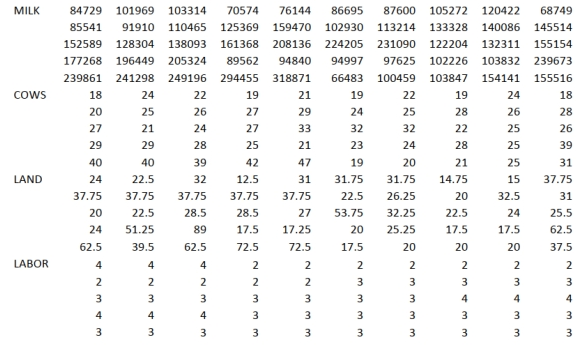SCENARIO 14-20-A
You are the CEO of a dairy company. You are planning to expand milk production by purchasing
additional cows, lands and hiring more workers. From the existing 50 farms owned by the company,
you have collected data on total milk production (in liters), the number of milking cows, land size (in
acres) and the number of laborers. The data are shown below and also available in the Excel file
Scenario14-20-DataA.XLSX.
S 
You believe that the number of milking cows , land size and the number of laborers are the best predictors for total milk production on any given farm.
-Referring to Scenario 14-20-A, what are the numerator and denominator degrees of freedom,
respectively, for the test statistic to determine whether there is a significant relationship between
total milk production and the entire set of explanatory variables?
Definitions:
Toxic Metals
Heavy metals and metalloids that are toxic to organisms, including mercury, lead, and arsenic, often contaminating the environment through industrial processes.
Wind Pollinated
Refers to plants that rely on wind to disperse their pollen as a means of fertilization, rather than depending on animals or insects.
Low Fitness
Refers to individuals having fewer offspring than average, contributing less genetic material to the next generation.
Resistant Populations
Groups of organisms that have developed the ability to withstand environmental pressures, such as chemicals or diseases, that would normally be harmful.
Q62: Referring to Scenario 15-7-A, the model
Q67: Referring to Scenario 12-14, the rank given
Q73: Referring to Scenario 13-11, what is the
Q80: Referring to Scenario 13-2, what is the
Q97: Referring to Scenario 11-1, the within groups
Q125: Referring to Scenario 15-7-B, there is insufficient
Q143: Referring to Scenario 14-15, what is the
Q145: Referring to Scenario 14-15, which of
Q238: Referring to Scenario 14-5, what are the
Q243: Referring to Scenario 14-18, what is the